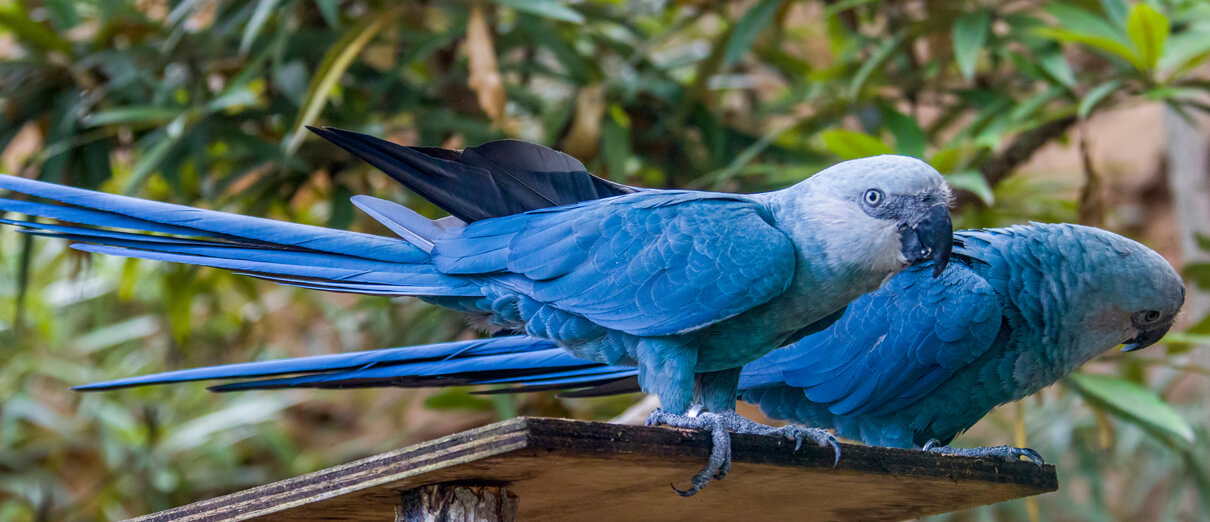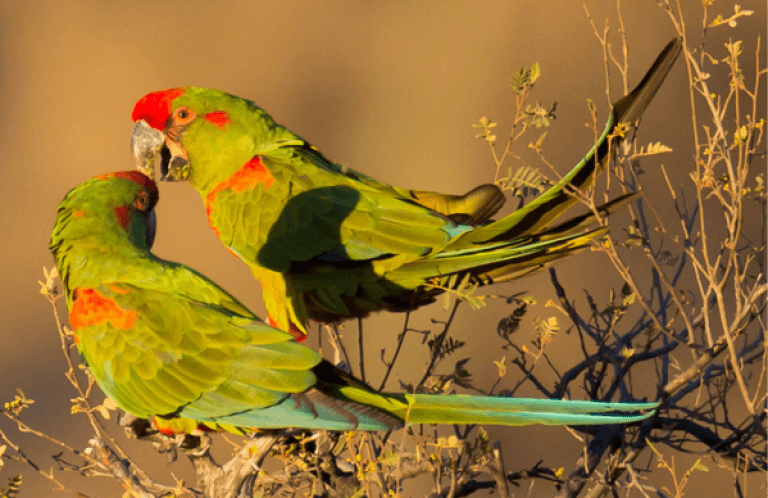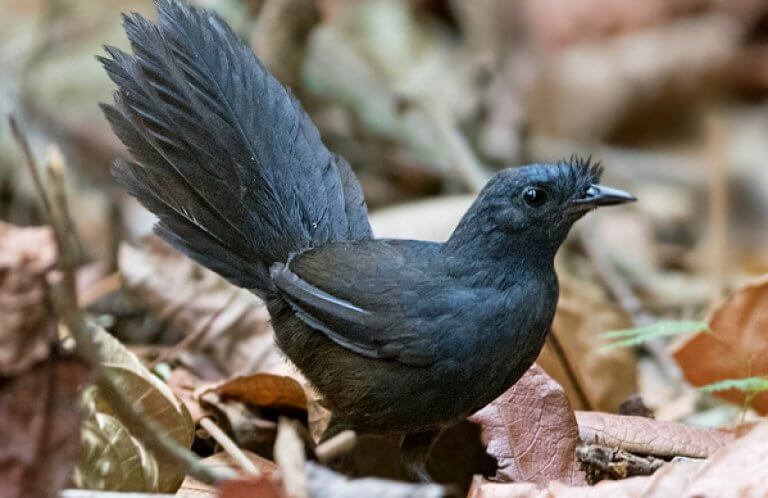About the Spix's Macaw
Also known as the Little Blue Macaw and as Ararinha Azul in Brazil, the Spix's Macaw was an enigma, from its discovery to its last day in the wild. This gray-headed blue parrot was recognized as a species in 1832, 13 years after the first specimen was collected and then misidentified as a Hyacinth Macaw by Johann Baptist Ritter von Spix. The next report of a wild bird came in 1903, followed by a very long dry spell until 1985, when five individuals were counted. By the end of 1987, just one wild male remained. The International Union for Conservation of Nature officially declared the species Extinct in the Wild in 2019.
A bird of Brazil's dry, thorny Caatinga, the Spix's Macaw succumbed to persistent habitat loss and illegal poaching for the wild bird trade. These twin threats have sparked tailspins in other rare parrot populations, including those of Bolivia's Blue-throated and Red-fronted Macaws; the Great Green Macaw; and another Brazilian endemic, the now-recovering Lear's Macaw.
Thanks to animated movies, songs, documentaries, paintings, and education programs, many people around the world now recognize the Spix's Macaw and its plight. An international team of partners has strived for decades to bring this species back to the wild, breeding and now releasing captive-raised birds. One of the challenges facing birds being reintroduced to the Caatinga comes from a beloved but ecologically vexing animal.
Enter the Goat
Able to thrive in rugged landscapes, the goat has long been valued as an important protein source in the region where the Spix's Macaw once occurred. No-fuss farm animals, goats don't need green pastures. They eat just about any plants they encounter. This adaptability means that goats will ravage sensitive habitats — including the Caatinga — if left unchecked. (In the U.S. and other parts of the world, goats are sometimes praised for providing an environmentally friendly way to clear areas for firebreaks or to provide pesticide-free weed control. In most of these cases, though, the animals' movements are controlled by shepherds or temporary fencing.)
Goats remain extremely important to communities in the Caatinga, but many people there also hail the reintroduction of the famous blue macaw. As in many areas where rare birds are under threat, local support is crucial to the macaw's recovery. As reforestation commences, planted areas will need to be fenced, and goat foraging will need to be limited in key conservation areas.
Songs and Sounds
Von Spix wrote that the blue macaw he'd shot was “notable for its thin voice.” The Spix's Macaw has a flatter, more nasal quality to its calls than the resonant screeches of many of the larger macaws. Some notes sound almost crow-like.
Listen here:
Breeding and Feeding
Streamside Nurseries
Like most other macaws, the Spix's Macaw depends upon mature trees for nest cavities. In this species' case, mature Caraibeira trees, which often grow along streams, provided the main nest sites. A female usually lays two to three eggs, which she incubates for almost a month. Once hatched, nestlings remain in the nest cavity for two months, before emerging to follow and receive food from their parents for another three months. Spix's Macaws don't reach breeding age until about four years old.

Much remains to be learned about the Spix's Macaw's diet in the wild, although a number of native trees are known to provide seeds and fruits eaten by this bird.
Region and Range

The Spix's Macaw is endemic to Caatinga habitat in a small part of northeastern Brazil. Reforestation efforts to restore areas of the Caatinga benefit not only the macaws, but also hundreds of other species. These include the Greater Rhea, Ruby-topaz Hummingbird, Swallow-tailed Hummingbird, Campo Troupial, and Pileated Finch. (The Lear's Macaw occurs only 100 miles away, near Canudos, Brazil.)
Conservation of the Spix's Macaw
The Spix's Macaw was always considered rare, but centuries of deforestation and habitat degradation, then capture for the bird trade, brought an end to the wild population.
Although captive breeding is now giving the Spix's Macaw a chance at returning to the wild, for well over a century, bird fanciers illegally purchased wild birds for their collections, fueling their decline. In recent years, Brazil's government, conservation organizations, and bird breeders came together to work on the reintroduction effort, the first releases of which began in June 2022.
Reintroducing captive-raised birds to the wild is a high-stakes gamble that must be coordinated with efforts to bring back the much-reduced Caatinga. Eight birds were released in June, with plans for others to follow. Joining these pioneer birds were eight wild-caught, then released Blue-winged Macaws. The hope is that these savvy birds will help the captive-raised Spix's Macaws benefit from safety in numbers and shared knowledge of feeding and safe nesting and roosting areas. Both species occur in the Caatinga, although the smaller Blue-winged Macaw is more plentiful and has a much wider range. Another dozen Spix's Macaws will likely be released by the end of 2022.
Habitat loss is the most critical threat to many of the world's bird species. The Spix's Macaw reintroduction effort, combined with habitat protection, may help to recover this species, but many others, such as Brazil's exceedingly rare (or possibly extinct) Stresemann's Bristlefront, have no prospects for reintroduction — only the hope that their last habitats will be saved. ABC works with more than 50 partners in a reserve system spanning more than 1 million acres, where the aim is to save the rarest of rare bird species from extinction.
A new challenge has emerged: Wind energy development is planned in the area where the Spix's Macaw reintroductions are occurring. ABC and its conservation partners hope to ensure that these birds and, to the south, Lear's Macaws, remain safe from planned wind energy projects that pose collision risks.
Get Involved
Many of the rarest bird species in the Western Hemisphere remain relatively unknown. You can learn more about these birds and the threats they face by signing up for ABC's Bird of the Week email series, which frequently highlights these fascinating birds.
American Bird Conservancy and our partners throughout Latin America and the Caribbean have created and expanded more than 100 bird reserves, which protect upward of 1.1 million acres of vital habitat. Together, we've planted more than 6.8 million trees and shrubs, helping to restore degraded and damaged habitat. You can help us continue to protect endangered birds by making a gift today.



















































